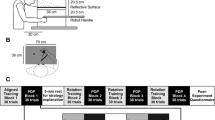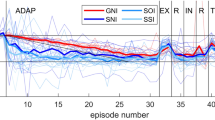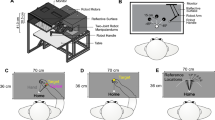Abstract
The Process Dissociation Procedure (PDP) and Verbal Report Framework (VRF) reveal that both explicit (conscious) and implicit (unconscious) processes contribute to visuomotor adaptation. We looked to determine whether these two assessment methods establish similar processes underlying visuomotor adaptation by comparing the magnitude of explicit and implicit adaptation over time between the two assessments and to post-experiment assessments of awareness of the visuomotor distortion. Three groups of participants (PDP, VRF, VRF No-Cursor) completed three blocks of reach training in a virtual environment with a cursor rotated 40° clockwise relative to hand motion. Explicit and implicit adaptations were assessed immediately following each block, and again 5 min later. The VRF No-Cursor group completed the same assessment trials as the VRF group, but no visual feedback was presented during explicit and implicit assessment. Finally, participants completed a post-experiment questionnaire and a drawing task to assess their awareness of the visuomotor rotation and changes in reaches at the end of the experiment, respectively. We found that all groups adapted their reaches to the rotation. Averaged across participants, the magnitude and retention of explicit and implicit adaptations were similar between the PDP group and VRF group, with the VRF group demonstrating greater implicit adaptation than the VRF No-Cursor group. Furthermore, the magnitude of explicit adaptation established in the VRF group was not related to participant’s post-experiment awareness of the visuomotor distortion nor how they had changed their reaches, as observed in the PDP group and VRF No-Cursor group. Together, these results indicate that, explicit adaptation established via typical VRF methods does not reflect one’s awareness of the visuomotor distortion at the end of the experiment, and hence the established processes underlying visuomotor adaptation are dependent on method of assessment (i.e., PDP versus VRF).






Similar content being viewed by others
Data availability
Please see the Supplementary material.
References
Baraduc P, Wolpert DM (2002) Adaptation to a visuomotor shift depends on the starting posture. J Neurophysiol 88(2):973–981. https://doi.org/10.1152/jn.2002.88.2.973
Barkley V, Salomonczyk D, Cressman EK, Henriques DYP (2014) Reach adaptation and proprioceptive recalibration following terminal visual feedback of the hand. Front Hum Neurosci 8:1–11. https://doi.org/10.3389/fnhum.2014.00705
Benson BL, Anguera JA, Seidler RD (2011) A spatial explicit strategy reduces error but interferes with sensorimotor adaptation. J Neurophysiol 105(6):2843–2851. https://doi.org/10.1152/jn.00002.2011
Bond KM, Taylor JA (2015) Flexible explicit but rigid implicit learning in a visuomotor adaptation task. J Neurophysiol 113(10):3836–3849. https://doi.org/10.1152/jn.00009.2015
Bouchard JM, Cressman EK (2021) Intermanual transfer and retention of visuomotor adaptation to a large visuomotor distortion are driven by explicit processes. PLoS One 16(1):e0245184
Buch ER, Young S, Contreras-Vidal JL (2003) Visuomotor adaptation in normal aging. Learn Mem 10(1):55–63. https://doi.org/10.1101/lm.50303
Cleeremans A and Elman J (1993) Mechanisms of implicit learning: connectionist models of sequence processing, MIT press.
Cressman EK, Henriques DYP (2009) Sensory recalibration of hand position following visuomotor adaptation. J Neurophysiol 102(6):3505–3518. https://doi.org/10.1152/jn.00514.2009
Cressman EK, Henriques DY (2010) Reach adaptation and proprioceptive recalibration following exposure to misaligned sensory input. J Neurophysiol 103(4):1888–1895
Cressman EK, Salomonczyk D, Henriques DY (2010) Visuomotor adaptation and proprioceptive recalibration in older adults. Exp Brain Res 205(4):533–544
de Brouwer AJ, Albaghdadi M, Flanagan JR, Gallivan JP (2018) Using gaze behavior to parcellate the explicit and implicit contributions to visuomotor learning. J Neurophysiol 120(4):1602–1615. https://doi.org/10.1152/jn.00113.2018
Ghahramani, Z., Wolpert, D. M., and Jordan, M. I. (1996). Generalization to local remappings of the visuomotor coordinate transformation. The Journal of Neuroscience : The Official Journal of the Society for Neuroscience, 16(21): 7085–7096. Retrieved from http://www.ncbi.nlm.nih.gov/pubmed/8824344
Glover S (2004) Separate visual representations in the planning and control of action. Behav Brain Sci 27(01):3–78. https://doi.org/10.1017/s0140525x04000020
Glover SR, Dixon P (2001) Dynamic illusion effects in a reaching task: evidence for separate visual representations in the planning and control of reaching. J Exp Psychol Hum Percept Perform 27(3):560
Goodale MA, Milner AD (1992) Separate visual pathways for perception and action. Trends Neurosci 15(1):20–25
Hadjiosif AM, Krakauer JW (2021) The explicit/implicit distinction in studies of visuomotor learning: conceptual and methodological pitfalls. Eur J Neurosci 53(2):499–503. https://doi.org/10.1111/ejn.14984
Heuer H, Hegele M (2015) Explicit and implicit components of visuo-motor adaptation: an analysis of individual differences. Conscious Cogn 33:156–169
Hwang EJ, Smith MA, Shadmehr R (2006) Dissociable effects of the implicit and explicit memory systems on learning control of reaching. Exp Brain Res 173(3):425–437. https://doi.org/10.1007/s00221-006-0391-0
Jacoby LL (1991) A process dissociation framework: Separating automatic from intentional uses of memory. J Mem Lang 30(5):513–541
Kim HE, Parvin DE, Ivry RB (2019) The influence of task outcome on implicit motor learning. Elife 8:e39882
Krakauer JW, Ghilardi MF, Ghez C (1999) Independent learning of internal models for kinematic and dynamic control of reaching. Nat Neurosci 2(11):1026–1031. https://doi.org/10.1038/14826
Larssen BC, Ong NT, Hodges NJ (2012) Watch and learn: Seeing is better than doing when acquiring consecutive motor tasks. PLoS One 7(6):e38938. https://doi.org/10.1371/journal.pone.0038938
Leow LA, Gunn R, Marinovic W, Carroll TJ (2017) Estimating the implicit component of visuomotor rotation learning by constraining movement preparation time. J Neurophysiol 118(2):666–676
Mandler G (1980) Recognizing: the judgment of previous occurrence. Psychol Rev 87(3):252
Maresch J, Mudrik L, Donchin O (2020) Measures of explicit and implicit in motor learning: what we know and what we don’t. OSF Preprints. https://doi.org/10.31219/osf.io/pzr7t
Maresch J, Werner S, Donchin O (2021) Methods matter: your measures of explicit and implicit processes in visuomotor adaptation affect your results. Euro J Neurosci 53(2):504–518
Mazzoni P, Krakauer JW (2006) An implicit plan overrides an explicit strategy during visuomotor adaptation. J Neurosci 26(14):3642–3645
McDougle SD, Taylor JA (2019) Dissociable cognitive strategies for sensorimotor learning. Nat Commun 10(1):1–13
McDougle SD, Bond KM, Taylor JA (2015) Explicit and implicit processes constitute the fast and slow processes of sensorimotor learning. J Neurosci 35(26):9568–9579. https://doi.org/10.1523/jneurosci.5061-14.2015
Merikle PM, Reingold EM (1990) Recognition and lexical decision without detection: Unconscious perception? J Exp Psychol Hum Percept Perform 16(3):574
Milner AD, Goodale MA (2008) Two visual systems re-viewed. Neuropsychologia 46(3):774–785
Modchalingam S, Vachon CM, Hart BMT, Henriques DYP (2019) The effects of awareness of the perturbation during motor adaptation on hand localization. PLoS One 14(8):1–20. https://doi.org/10.1371/journal.pone.0220884
Murphy KJ, Racicot CI, Goodale MA (1996) The use of visuomotor cues as a strategy for making perceptual judgments in a patient with visual form agnosia. Neuropsychology 10(3):396
Neville KM, Cressman EK (2018) The influence of awareness on explicit and implicit contributions to visuomotor adaptation over time. Exp Brain Res 236(7):2047–2059. https://doi.org/10.1007/s00221-018-5282-7
Oldfield (1971) Hand preference. Encycl Clin Neuropsychol. https://doi.org/10.1007/978-0-387-79948-3_6053
Ong NT, Hodges NJ (2010) Absence of after-effects for observers after watching a visuomotor adaptation. Exp Brain Res 205(3):325–334. https://doi.org/10.1007/s00221-010-2366-4
Ong NT, Larssen BC, Hodges NJ (2012) In the absence of physical practice, observation and imagery do not result in updating of internal models for aiming. Exp Brain Res 218(1):9–19. https://doi.org/10.1007/s00221-011-2996-1
Poh E, Carroll TJ, Taylor JA (2016) Effect of coordinate frame compatibility on the transfer of implicit and explicit learning across limbs. J Neurophysiol 116(3):1239–1249. https://doi.org/10.1152/jn.00410.2016
Salomonczyk D, Cressman EK, Henriques DYP (2011) Proprioceptive recalibration following prolonged training and increasing distortions in visuomotor adaptation. Neuropsychologia 49(11):3053–3062. https://doi.org/10.1016/j.neuropsychologia.2011.07.006
Shanks DR, MarkJohn FS (1994) Characteristics of dissociable human learning systems. Behav Brain Sci 17(3):367–395
Taylor JA, Ivry RB (2011) Flexible cognitive strategies during motor learning. PLoS Comput Biol 7(3):e1001096
Taylor, J. A., and Ivry, R. B. (2014). Cerebellar and prefrontal cortex contributions to adaptation, strategies, and reinforcement learning. Progress in brain research (1st ed., Vol. 210). Elsevier https://doi.org/10.1016/B978-0-444-63356-9.00009-1
Taylor JA, Krakauer JW, Ivry RB (2014) Explicit and implicit contributions to learning in a sensorimotor adaptation task. J Neurosci 34(8):3023–3032. https://doi.org/10.1523/JNEUROSCI.3619-13.2014
Tseng Y-W, Diedrichsen J, Krakauer JW, Shadmehr R, Bastian AJ (2007) Sensory prediction errors drive cerebellum-dependent adaptation of reaching. J Neurophysiol 98:54–62. https://doi.org/10.1152/jn.00266.2007 (PMID: 17507504)
Vetter P, Goodbody SJ, Wolpert DM (1999) Evidence for an eye-centered spherical representation of the visuomotor map. J Neurophysiol 81(2):935–939
Wang J, Joshi M, Lei Y (2011) The extent of interlimb transfer following adaptation to a novel visuomotor condition does not depend on awareness of the condition. J Neurophysiol 106(1):259–264
Werner S, Van Aken BC, Hulst T, Frens MA, Van Der Geest JN, Strüder HK, Donchin O (2015) Awareness of sensorimotor adaptation to visual rotations of different size. PLoS One 10(4):1–18. https://doi.org/10.1371/journal.pone.0123321
Werner S, Strüder HK, Donchin O (2019) Intermanual transfer of visuomotor adaptation is related to awareness. PLoS One 14(9):1–19. https://doi.org/10.1371/journal.pone.0220748
Wolpert DM, Kawato M (1998) Multiple paired forward and inverse models for motor control. Neural Netw 11(7–8):1317–1329. https://doi.org/10.1016/S0893-6080(98)00066-5
Wolpert DM, Ghahramani Z, Jordan MI (1995) An internal model for sensorimotor integration. Science 269(5232):1880–1882
Funding
This research was supported by the Natural Sciences and Engineering Research Council of Canada (Discovery Grant) awarded to Erin K. Cressman.
Author information
Authors and Affiliations
Corresponding author
Ethics declarations
Conflict of interest
All authors declare that they have no conflict of interest.
Additional information
Communicated by Melvyn A. Goodale.
Publisher's Note
Springer Nature remains neutral with regard to jurisdictional claims in published maps and institutional affiliations.
Supplementary Information
Below is the link to the electronic supplementary material.
Rights and permissions
About this article
Cite this article
Heirani Moghaddam, S., Chua, R. & Cressman, E.K. Assessing and defining explicit processes in visuomotor adaptation. Exp Brain Res 239, 2025–2041 (2021). https://doi.org/10.1007/s00221-021-06109-5
Received:
Accepted:
Published:
Issue Date:
DOI: https://doi.org/10.1007/s00221-021-06109-5




